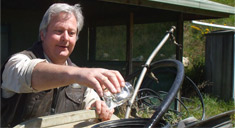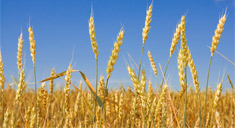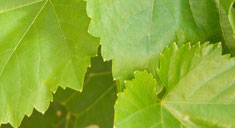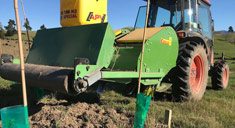Homeopathy for Plants – Case Practice
After giving an introduction and explaining the theoretical background of Homeopathy for Plants in Part 1
Part 2 will cover more details and case practice.
In homeopathy you look at plant and soil in its whole picture with various symptoms and conditions, to create a case to be treated. Homeopathy treats the whole plant with its roots and leaves and the soil it is growing in. Through exact observation of plants and soil, based on thorough trials and clear experience, the correct treatment can be chosen which parallels those symptoms and conditions in exactly the same energy pattern which the dis-ease and imbalance portrays as the case picture.
The resilience and fitness of the plants and in the soil is strengthened and encouraged. Resilience being understood as a biological systems resistance to interference, stress and incrimination.
Early season
During spring you want to sow seeds and transplant grafted trees and vines under optimum soil and weather conditions. Your topsoil is to be teeming with life of the soil food web waiting with a good crumb structure with worm canals and pores to be filled with rain water. At that time be ready to take in the full picture of each case of plant and soil health which is similar to peeling an onion layer by layer.
To encourage germination and good early growth you prepare with a spray or watering application of Arnica C 200 in the same way as you have already done after winter pruning. One week later we can follow up with Calendula C 30, another plant and root strengthening product that also has anti-bacterial qualities and a general revitalising effect which makes it suitable for transplanting and repotting as well. A third spring application is Calcium carbonicum (ex oyster shells) in a D 6 potency which is an ideal tonic to boost plant and root growth during cold water and air conditions.
After germination, once you can see the first tender leaves growing, you want to make sure that they will not get eaten by slugs and snails. To prevent any damage apply Helix tosta D 6 which is made of roasted snails similar to the ashes in biodynamic farming. In our own trials young lettuce plants grown of seeds and transplanted in October last year did extremely well without the slightest bit of snail damage on our Marahau property.
Disease prevention and stress relief
When wet, humid or warm weather is bringing on the risk of your plants being infected with fungi, use the appropriate remedy once or twice to protect them. If the first signs of fungal disease are already visible, it is safer to water or spray your plants every 2-3 days until they show distinct improvement. Once the plants appear to be healthier, it will be sufficient to treat them at longer intervals as needed.
Aconitum napellus C 200 is a very good remedy to treat sudden symptoms where plants wilt and dry out very quickly. Or after weather damage as a result of cold, dry, southerly winds or after warm days and very cold nights. Sudden symptoms also indicate for Belladonna C 200 where leaves turn reddish to reddish brown, mainly after frost followed by intense sunshine periods. Or after long cold periods with rain and leaves are exposed to moisture for too long. Belladonna creates a warmth atmosphere and is also good as a compost starter if you have a compost going.
Another good plant and soil strengthener is Carbo vegetabilis (ex charcoal) which helps to prevent brown rot, canker and monilia, especially after cold and frost and changes from warm to cold weather. Cuprum met. C 30 is the third plant strengthening remedy which can prevent brown rot, downy and powdery mildew. After long rainy periods and after cold, dry wind. This sounds like an incomprehensible paradox but this is part of homeopathy because Cuprum can also both boost and inhibit growth. Similar to Cuprum is Pulsatilla (Anemone) C 200 with its balancing warmth factor that is indicated after longer spells of wet weather with cold rain and after weather changes.
Silicea C 30 is a tonic which strengthens the plant’s cell tissue, promotes plant regeneration and helps after weather changes, with consequences of waterlogging around the roots and consequences of heat damage (sunburn) later in the season. Thuja C 200 protects plants from diseases in cold spring or summer seasons and is indiacted with leaf spot, brown rot, leaf curl, mildew and monilia.
Insect problems
Cimicifuga (Black cohosh) C 30 and Staphisagria (Delphinium) C 200 have both proven good results with aphids on roses and mites on fruit trees and on grapevines (own trials). So has Petroleum C 30 on scale. Cimicifuga is indicated if leaves, blossom and new shoots are curling and rolling up. Staphisagria after plants are weakened by damage. Petroleum with sticky leaves and scale insects are on both sides of the leaves.
Homeopathy for plants can guide you safely through the season because you can treat the plants and the soil instead of the pest insect or the disease. In high potencies C 30 and higher, even highly toxic substances are rendered harmless because these remedies only carry the energy imprint but not substance itself any more. Leaves and roots take up the remedies just alike and let you know when you have made the correct choice.
Please let the author know any results of your homeopathic plant use by email or telephone, whether positive or negative and together we can build a future knowledge network.
Same literature as Part 1 plus own trial results


Contact Us
General enquiries welcomed. Request consultancy advice or speak to Andreas directly.
Contact Andreas

Order Online Now
Order our Farm and Plant Homeopathic and Organic & Biodynamic Viticulture & Horticulture products.
Order Online

Plant Homeopathy
Based on classical homeopathic principles, we offer advice on homeopathic treatment
Read On ...

Soil Cultivation
ESTA Soil Tests and analysis and Soil Management using the Spade Machine.
Find out more